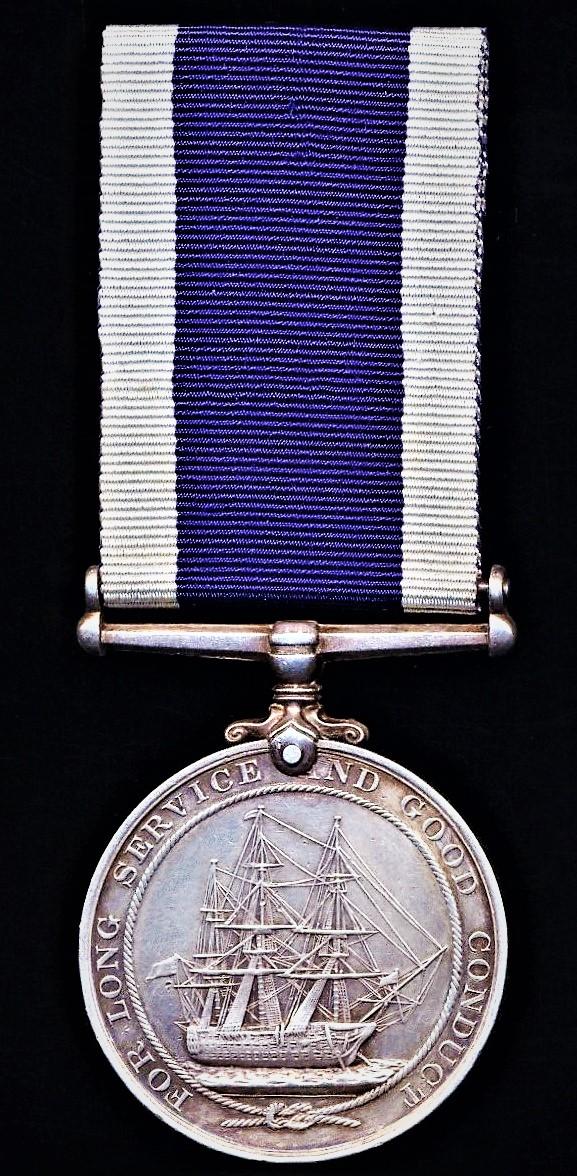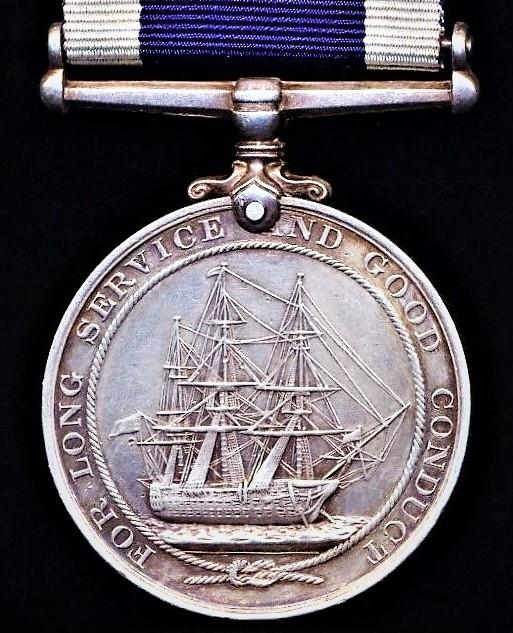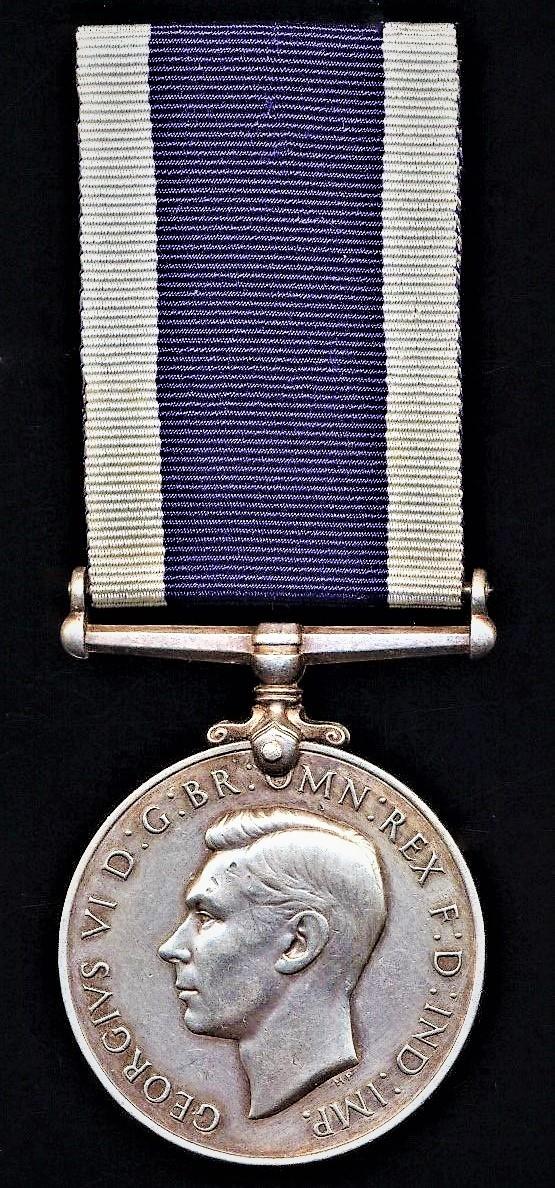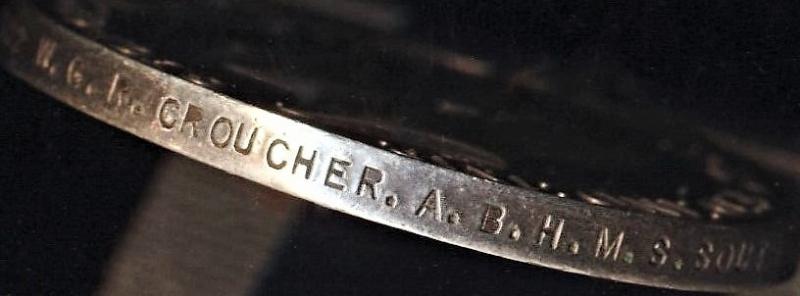Naval Long Service and Good Conduct Medal. GVI 1st issue (J. 97722 W. G. R. Croucher. A. B. H.M.S. Southampton.)
Medal verification: The award of the Naval Long Service & Good Conduct Medal is confirmed per the respective naval medal roll (ref ADM 171/151), which shows that the recipient was issued his medal on, 26 March 1938, and sent to him at H.M.S. Southampton in, April 1938 (his service sheet records that the medal was 'Traced' earlier on, 7 March 1938). In addition to his long service medal, Able Seaman Croucher is also confirmed from his naval postings and services shown on his extant service sheet (held and accessible at The National Archives) to have been entitled to the below following Second World War campaign medals:
- The 1939-1945 Star (H.M.S. Brilliant 1939-42)
- The Atlantic Star (H.M.S. Brilliant 1939-42)
- Defence Medal (Traced pension 14/2/1945)
- War Medal (H.M.S. Brilliant 1939-42)
William George Robert Croucher, son of William Robert Croucher (No 50183 Gunner, 90th Battery Royal Garrison Artillery Killed-in-Action, at 'Gallipoli', 7 August 1915) and Annie Elizabeth Croucher (nee Hucker) was a native of the parish of Bushy, Hertfordshire, England, where he was born on, 3 March 1905. William was employed as a 'Golf Caddie' prior to joining the Royal Navy on, 25 June 1920, on which date he was appointed the rate Boy II, at the tender age of just 15 years and 3 months! During the inter-war years Alexander served on a variety of ships and stations, including service aboard the mighty aircraft carrier, H.M.S. Ark Royal (1929-1930) , the Malta shore base ST. Angelo / destroyer H.M.S. Arrow 1932-1933, and the light cruiser H.M.S. Southampton (1937-1939). For the first two years of the Second World War William served as a member of the crew of H.M.S. Brilliant. He was appointed Acting Petty Officer on, 23 September 1941 (H.M.S. Edinburgh Castle), and Temporary Petty Officer on, 23 September 1942 (H.M.S. Ajax). William George Robert Croucher retired from the Royal Navy, when he took his discharge from H.M.S. Pembroke on, 31 October 1945. He is reported to having died at, Watford, Hertfordshire, England, sometime in, 1966
HMS Brilliant: A B-class destroyer built for the Royal Navy (RN) around 1930. She spent most of World War II on convoy escort duties in the English Channel, and the North Atlantic, based at Dover, Gibraltar, and Freetown, Sierra Leone.The ship became a target ship at the end of the war and was scrapped in 1948
At the outbreak of war in September 1939, Brilliant was assigned to the 19th Destroyer Flotilla at Dover and spent the time before the Battle of France escorting convoys and minelaying operations. She collided with the breakwater at Dover on 12 September and required six weeks for repairs. On 12 May 1940, the ship took part in Operation XD, the destruction of Dutch port facilities and returned with 100 evacuees aboard. On 15 May Brilliant collided with her sister ship Boreas en-route for the Hook of Holland and was under repair at Sheerness Dockyard until 17 June. She was then transferred to the 1st Destroyer Flotilla at Dover, as the heavy losses suffered during the Dunkirk evacuation forced the disbandment of the 19th Flotilla. On 25 July, the ship engaged German E-boats off Dover Harbour together with Boreas and was badly damaged by German Junkers Ju 87 "Stuka" dive bombers after she was ordered to withdraw. Brilliant was attacked by eight "Stuka"s and the ship was hit by two bombs that passed through the hull without exploding. No one was injured, but the steering gear was disabled and she stopped and flooded by the stern. The ship was lightened by jettisoning her aft guns and depth charges and was towed back to Dover. Brilliant was under repair at Chatham Dockyard until mid-October
Upon their completion, the ship was assigned to Home Fleet until February 1941 and was then refitted at Southampton in March. At this time she was fitted with a Type 286 short-range surface search radar. On 12 May, Brilliant was sailed for Freetown, Sierra Leone where she served as a local escort and searched for German blockade runners and supply ships until returning home in April 1942 for a refit at Chatham. After the refit, the ship escorted a convoy to Durban, South Africa in May 1942 before returning to Freetown in August. On 4 and 5 June, the ship, together with the heavy cruiser London, intercepted the oil tankers MV Esso Hamburg and SS Egerland, respectively. Both ships scuttled themselves to prevent their capture. Brilliant became leader of the 18th Destroyer Flotilla in August 1942
Condition: About GVF
Code: 23184







